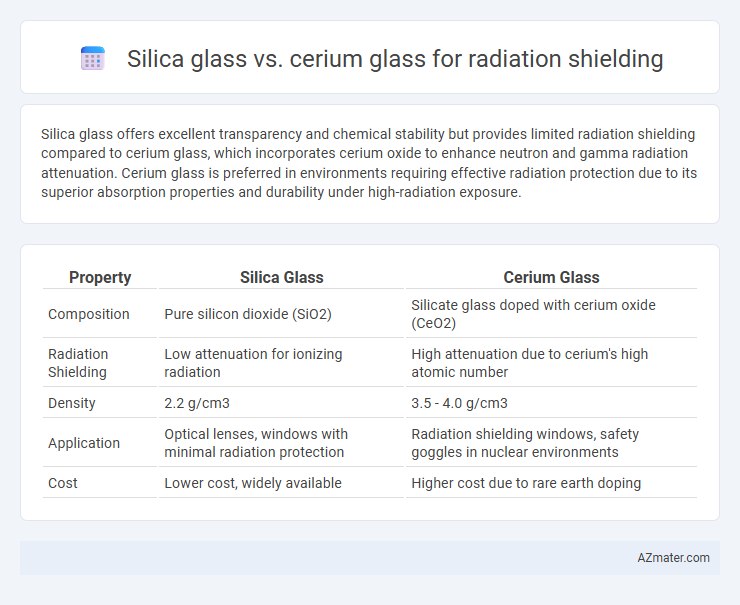Silica glass offers excellent transparency and chemical stability but provides limited radiation shielding compared to cerium glass, which incorporates cerium oxide to enhance neutron and gamma radiation attenuation. Cerium glass is preferred in environments requiring effective radiation protection due to its superior absorption properties and durability under high-radiation exposure.
Table of Comparison
| Property | Silica Glass | Cerium Glass |
|---|---|---|
| Composition | Pure silicon dioxide (SiO2) | Silicate glass doped with cerium oxide (CeO2) |
| Radiation Shielding | Low attenuation for ionizing radiation | High attenuation due to cerium's high atomic number |
| Density | 2.2 g/cm3 | 3.5 - 4.0 g/cm3 |
| Application | Optical lenses, windows with minimal radiation protection | Radiation shielding windows, safety goggles in nuclear environments |
| Cost | Lower cost, widely available | Higher cost due to rare earth doping |
Introduction to Radiation Shielding Materials
Radiation shielding materials play a crucial role in protecting personnel and equipment from harmful ionizing radiation in medical, industrial, and nuclear applications. Silica glass offers high transparency and thermal stability but has limited effectiveness against gamma rays and neutrons due to its low atomic number. Cerium glass contains cerium oxide, providing enhanced attenuation of gamma radiation and improved radiation resistance, making it more suitable for specialized shielding in environments with high-energy radiation exposure.
Overview of Silica Glass
Silica glass, composed primarily of silicon dioxide (SiO2), offers moderate radiation shielding properties due to its density and atomic composition, making it suitable for low to moderate radiation environments. Its high optical clarity and thermal stability ensure minimal distortion under radiation exposure, while its relatively low atomic number limits its effectiveness against high-energy gamma rays compared to cerium glass. In contrast, cerium glass incorporates cerium oxide (CeO2), enhancing radiation absorption through its higher atomic number, but silica glass remains favored for applications requiring transparency and chemical inertness.
Overview of Cerium Glass
Cerium glass is a specialized radiation shielding material known for its high density and effective attenuation of gamma rays and X-rays, making it superior to standard silica glass in radiation protection. It incorporates cerium oxide, which enhances neutron and gamma radiation absorption without compromising optical clarity, ideal for medical and nuclear applications. The unique electronic configuration of cerium ions enables efficient interaction with ionizing radiation, resulting in improved shielding performance compared to traditional silica-based glasses.
Radiation Attenuation Properties
Cerium glass exhibits superior radiation attenuation properties compared to silica glass due to its higher atomic number and density, which allow it to more effectively absorb and scatter ionizing radiation such as gamma rays and X-rays. Silica glass, primarily composed of silicon dioxide with lower density and atomic number, provides less shielding and is more suitable for visible light transmission rather than radiation protection. In applications requiring enhanced radiation shielding, cerium glass's ability to reduce radiation penetration makes it a preferred choice over conventional silica-based materials.
Optical Clarity and Transparency
Silica glass offers superior optical clarity and high transparency across a broad visible spectrum, making it ideal for applications requiring clear visual observation during radiation shielding. Cerium glass, infused with cerium oxide, provides enhanced radiation absorption, especially for gamma and X-rays, but this addition often results in slightly reduced transparency and a characteristic yellow tint. The trade-off between optical clarity and radiation shielding effectiveness positions silica glass as preferable for clarity, while cerium glass excels when stronger radiation protection is prioritized without significantly compromising transparency.
Mechanical Strength and Durability
Silica glass exhibits high mechanical strength due to its rigid silicon-oxygen network, making it resistant to fractures and deformation under stress. Cerium glass enhances durability by incorporating cerium oxide, which absorbs ionizing radiation and reduces radiation-induced damage, thus maintaining structural integrity over time. Compared to silica glass, cerium glass offers superior radiation shielding capabilities while sustaining mechanical strength, making it ideal for environments with intense radiation exposure.
Chemical Stability under Radiation Exposure
Silica glass exhibits excellent chemical stability under radiation exposure due to its strong Si-O bonds, which resist structural degradation and maintain transparency. Cerium glass, while beneficial for neutron and gamma radiation shielding through its cerium oxide content, may undergo radiation-induced color center formation that can slightly affect its chemical integrity over extended exposure. Both materials have distinct chemical resilience profiles, with silica glass favored for long-term stability and cerium glass optimized for specific radiation attenuation with moderate chemical alterations under high radiation doses.
Cost and Availability Comparison
Silica glass is widely available and cost-effective due to its abundant raw materials and established manufacturing processes, making it a popular choice for radiation shielding applications. Cerium glass, while offering superior radiation attenuation properties, comes at a higher cost because of the rarity and expense of cerium oxide and the specialized production techniques required. The accessibility of silica glass in global markets significantly outpaces that of cerium glass, influencing budget-conscious projects to favor silica-based solutions despite Cerium glass's enhanced performance.
Typical Applications in Radiation Shielding
Silica glass is commonly used in radiation shielding for optical components in X-ray and UV systems due to its high transparency and thermal stability. Cerium glass is preferred in nuclear medicine and radiography, where its effective absorption of gamma rays and UV radiation enhances safety by reducing exposure. Both materials serve critical roles in radiation shielding, with cerium glass offering superior protection in environments with intense gamma radiation.
Conclusion: Choosing the Right Glass for Radiation Protection
Silica glass offers excellent optical clarity but provides limited radiation shielding due to its low atomic number elements, making it less effective against gamma and X-rays. Cerium glass, enriched with cerium oxide, significantly improves radiation attenuation by absorbing high-energy photons, making it the preferred choice in environments requiring robust protection. Selecting between silica and cerium glass depends on balancing optical performance with shielding efficiency, where cerium glass excels in protecting against ionizing radiation without sacrificing transparency.

Infographic: Silica glass vs Cerium glass for Radiation shielding
 azmater.com
azmater.com